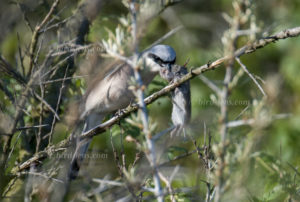 In June, the females of the Red-backed Shrike (Lanius collurio) are still sitting on their eggs. But towards the end of the month, they should start feeding the young birds. Then the nature photographer is already very excited. Over time, you get to know the pairs in an area quite well. One, of the total 8 pairs I watch, seems to have specialized in larger prey this season. At spit sites, I mostly find the shiny black dung beetles. But also the one or other lizard and even sometimes young field mice I could discover impaled on a Hawthorn (Crataegus monogyna). There it is often possible to observe the male catching prey, especially in the breeding phase. It seems that a larger kind of prey is used when the weather conditions are too bad for insect hunting.
In June, the females of the Red-backed Shrike (Lanius collurio) are still sitting on their eggs. But towards the end of the month, they should start feeding the young birds. Then the nature photographer is already very excited. Over time, you get to know the pairs in an area quite well. One, of the total 8 pairs I watch, seems to have specialized in larger prey this season. At spit sites, I mostly find the shiny black dung beetles. But also the one or other lizard and even sometimes young field mice I could discover impaled on a Hawthorn (Crataegus monogyna). There it is often possible to observe the male catching prey, especially in the breeding phase. It seems that a larger kind of prey is used when the weather conditions are too bad for insect hunting.
During resting the male Red-backed Shrike likes to sit on a branch of elderberry (Sambucus nigra) protruding from the hedge. Hedgerow landscapes with elder, hawthorn, blackthorn and blackberry, are the preferred habitat of the Red-backed Shrike. In the low mountain ranges, however, the Red-backed Shrike also regularly occurs on clear-cuts in the regeneration phase and in richly structured stream valleys.
Both partners participate equally in the approximately fortnightly feeding phase of the young birds in the nest. When photographing in the thicket of a hedge, a good telelens with a high aperture is useful to be able to separate the subject well from the background.
You should listen for high-pitched, soft but intense calls coming from a reforesting clearcut that is now replanting itself with European Spruce (Picea abies) and Rowan (Sorbus aucupariaeinem). Perhaps one can discover a just fledged young of the red-backed shrike roaming the nearer surroundings.
It is very promising to find one of the spitting sites of the Red-backed Shrike. There you can often and regularly find notched animals (like beetles) but also lizards and Field mice. Here it is called then to show patience. Popular perching points, from which the Red-backed Shrike looks for prey, are regularly approached. Therefore, it is relatively easy to photograph the birds from a camouflage tent. In order to have the shortest possible working distance, it is necessary to place the camouflage hide in the bird’s territory for a longer period of time.
Red-backed Shrikes prefer hunting from a perch. Such – for some time – static situations are usually photographed from a distance of five to eight meters. A greater distance is advantageous for action shots – such as the approach of the Red-backed Shrike to the nest or hunting a mouse. To avoid disturbing the birds, it is advisable to determine shooting points in advance so that the tripod-mounted lens does not have to be swung back and forth unnecessarily.
To meet the growing demand for top shots of the rarer species of the Palearctic, bird-lens.com has made targeted trips to the most beautiful natural landscapes of Brandenburg or Berlin but also to distant places. All this in order to be able to take excellent photos of the birds of the Western Palearctic. The yield of pictures also of rare Western Palearctic birds is very good. The nice picture you see in the blog is just a first impression, what you will find in behind the tab “Picture Shop” very soon. Just let bird-lens.com know if you need the picture of a bird species before new pictures are online.